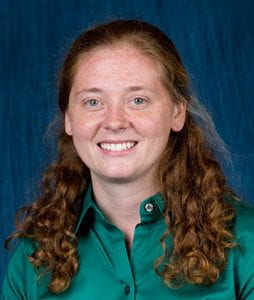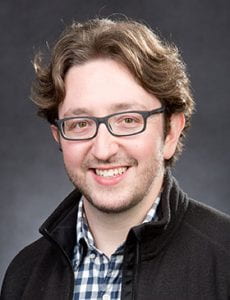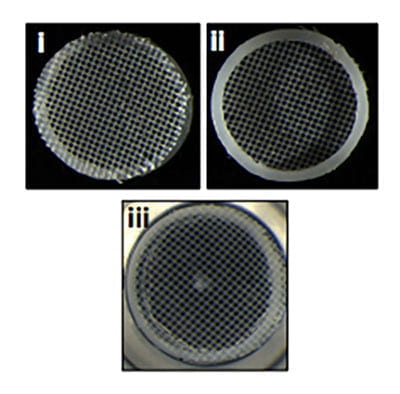Biology professors’ invention projected to generate global research
By Charlotte Smith ’20 & ’21G
Two faculty members in the Department of Biology have collaborated to develop the first institutional patent in College history — a product that is drawing interest from researchers domestically and internationally.
The invention of microtissue restraints, which are used in cell analysis, has led PC to enter into a contract manufacturing agreement with Arizona State University to manufacture and sell these products to third parties.
Created by Dr. Marla Tipping, associate professor of biology, and Dr. James Waters, associate professor of biology, microtissue restraints are small, plastic capture devices — disk-like structures that restrain small tissues while still allowing oxygen exchange — used in a cell plate for metabolic analysis.

The microtissue restraints allow for advanced, in-depth scientific analysis of small tissues, such as fruit fly brains. However, Tipping said there are broader capabilities for the product, pointing out the microtissue restraints will aid research in crucial metabolic areas.
“Metabolism is a hot topic in the research world right now for a lot of different diseases. Recently, researchers are seeing that a big shift occurs in metabolism over the course of a disease, and this can be a potential target for treatment as well,” explained Tipping, who specializes in molecular and cell biology.
Tipping said these microtissue restraints became necessary in a study looking at metabolism in flies, specifically within the brain. A product was needed to assist in the process of examining a specimen as small as this one.

Waters, whose area of expertise is the behavior, physiology, and natural history of ants, also knew the potential for manufacturing assistance at Arizona State University. He earned a Ph.D. in biology from ASU in 2012, and as a graduate student, had taken courses affiliated with the Physics Department’s student machine shop. His ongoing association with machine shop staff paid off, as the machinists agreed to manufacture the microtissue restraints.
A trial-and-error process with the ASU lab ensued, and multiple versions of the restraint were tested before a final product was attained.
Since the 2016-17 academic year, PC undergraduates have played a big role in the invention process. As Tipping explained, her research students were instrumental in optimizing the product by giving feedback and testing the restraints in order to ensure they had the correct measurements needed for use.
After Tipping wrote two journal articles about the microtissue restraints and included a video of the product being used, researchers became interested, with many asking where the product could be purchased.
With attention growing from the research community, a decision was made to try and obtain a patent for the product.

As part of the effort, Tipping and Waters have worked closely with Dr. Kris A. Monahan, director of sponsored projects and research compliance in the Office of Academic Affairs, and Rev. Thomas More Garrett,O.P., associate vice president and associate general counsel at the College. Monahan and Father Thomas More are also members of the Intellectual Property Committee, which is responsible for assessing and examining the commercialization and patentability of potential inventions that are disclosed by members of the College community.
“Kris was of great assistance in taking care of all the behind-the-scenes work in obtaining the patent with the College. She put me in contact with general counsel, attended meetings with me, and championed my side throughout the entire process,” said Tipping.
Father Thomas More worked to secure the patent rights to the product, collaborating with outside counsel to prepare the necessary documentation to obtain the patent.
Once a “patent-pending” status was received, it jumpstarted the negotiations of a contract manufacturing agreement. Monahan and Father Thomas More helped negotiate an agreement whereby ASU would remit the College a 5% royalty on net proceeds from any and all third-party sales.
Father Thomas More noted that while the microtissue restraints represent the College’s first registration, it is not the first by College faculty. “We have other faculty with patent registrations, but they hold them individually, or with a previous institution,” he said.
According to Monahan, it’s not every day that a small, Catholic, undergraduate institution plays such a major role in the scientific research community.
“I think it’s exciting that an institution that is not research based and is more focused on research for the betterment of teaching is bringing a patent that is new, different, and cutting edge,” she stated.
For Waters, the patent represents a declaration of something that is useful and new for the global research community. He said it is up to researchers to decide how they will use the microtissue restraints to generate new knowledge.
“I think it’s exciting that an institution that is not research based and is more focused on research for the betterment of teaching is bringing a patent that is new, different, and cutting edge.”
Dr. Kris A. Monahan
“Our goals have always been to disseminate information about this technique and encourage others to invest in its development so we can build a larger community of scientists studying the metabolism of microscopic tissues,” said Waters.
So far, at least 20 researchers domestically and internationally have expressed interest in purchasing the microtissue restraints.
While the College is awaiting final approval of the patent, those who have played a role in this process agree on one thing: What matters most is not so much the dollars, but the fact that a product developed by PC faculty will allow researchers worldwide to explore multiple areas of science, including potentially devising more effective treatment for disease.
#givingtuesday 2020




